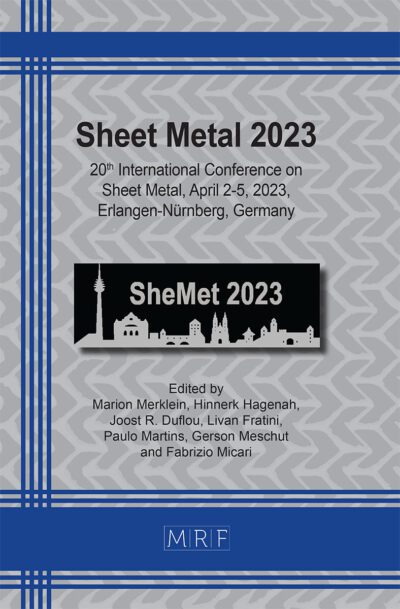–
Topology optimization for the design of additively manufactured hot stamping tools
YU Daoming, RACHIK Mohamed, BRUN Gilles, BLAISE Alexandre, SARRE Benjamin
download PDFAbstract. The hot stamping process makes it possible to obtain complex-shaped parts with high mechanical properties. The hot stamping production rate is driven by the cooling system inside the tool. Improving the efficiency of the cooling system is a key factor as it reduces part production time and thus lower the cost. But an optimized cooling system requires complex internal geometries. That is why the development of additive manufacturing (AM) opens up new and good prospects for designing and making hot stamping tools with high cooling efficiency. This research proposes a two-step topology optimization procedure for hot stamping tools’ design. In the first step, the fluid/thermal topology optimization is used to find the best design for the cooling system. As the printing time and cost for the additively manufactured tool depend on the amount of material used, the second step focuses on removing unnecessary materials in hot stamping tools.
Keywords
Topology Optimization, Additive Manufacturing, Hot-Stamping, Simulation
Published online 4/24/2024, 10 pages
Copyright © 2024 by the author(s)
Published under license by Materials Research Forum LLC., Millersville PA, USA
Citation: YU Daoming, RACHIK Mohamed, BRUN Gilles, BLAISE Alexandre, SARRE Benjamin, Topology optimization for the design of additively manufactured hot stamping tools, Materials Research Proceedings, Vol. 41, pp 1769-1778, 2024
DOI: https://doi.org/10.21741/9781644903131-196
The article was published as article 196 of the book Material Forming
![]() Content from this work may be used under the terms of the Creative Commons Attribution 3.0 license. Any further distribution of this work must maintain attribution to the author(s) and the title of the work, journal citation and DOI.
Content from this work may be used under the terms of the Creative Commons Attribution 3.0 license. Any further distribution of this work must maintain attribution to the author(s) and the title of the work, journal citation and DOI.
References
[1] D. Chantzis, X. Liu, D.J. Politis et al. Review on additive manufacturing of tooling for hot stamping. Int J Adv Manuf Technol 109 (2020) 87–107. https://doi.org/10.1007/s00170-020-05622-1
[2] N. Asnafi, J. Rajalampi, D. Aspenberg et al. Production Tools Made by Additive Manufacturing Through Laser-based Powder Bed Fusion. Berg Huettenmaenn Monatsh 165 (2020) 125–136. https://doi.org/10.1007/s00501-020-00961-8
[3] K. Liu, A. Tovar, An efficient 3D topology optimization code written in Matlab. Struct Multidisc Optim 50 (2014) 1175–1196. https://doi.org/10.1007/s00158-014-1107-x
[4] F. Hecht. New development in FreeFem++. Journal of Numerical Mathematics. 20.10.1515/jnum-2012-0013.
[5] J. Alexandersen, C.S. Andreasen. A Review of Topology Optimisation for Fluid-Based Problems. Fluids 5(1):29 (2020). https://doi.org/10.3390/fluids5010029
[6] Z. Shan, M. Zhang, C. Jiang et al. Basic study on die cooling system of hot stamping process. ATDM 2010, Beijing, 2010, pp. 1-4, doi: 10.1049/cp.2010.1248.
[7] Y. Sato, K. Yaji, K. Izui et al. An Optimum Design Method for a Thermal-Fluid Device Incorporating Multiobjective Topology Optimization With an Adaptive Weighting Scheme. ASME. J. Mech. Des. 140(3) (2018) 031402. https://doi.org/10.1115/1.4038209
[8] M. Yu, X. Wang, J. Gu et al. A synergic topology optimization approach on distribution of cooling channels and diverse-intensity heat sources for liquid-cooled heat sink. Struct Multidisc Optim 65 (2022) 48. https://doi.org/10.1007/s00158-021-03113-9
[9] P. Jolivet, V. Dolean, F. Hecht et al. High performance domain decomposition methods on massively parallel architectures with freefem++. Journal of Numerical Mathematics, 20(3-4) (2012) 287-302. https://doi.org/10.1515/jnum-2012-0015
[10] S. Sun, P. Liebersbach, X. Qian. 3D Topology Optimization of Heat Sinks for Liquid Cooling. Applied Thermal Engineering. 178. 115540. 10.1016/j.applthermaleng.2020.115540.
[11] A. Saysroy, S. Eiamsa-ard. Enhancing convective heat transfer in laminar and turbulent flow regions using multi-channel twisted tape inserts. International Journal of Thermal Sciences. 121. 55-74. 10.1016/j.ijthermalsci.2017.07.002.
[12] P. Hu, B. He, L. Ying. Numerical investigation on cooling performance of hot stamping tool with various channel designs. Applied Thermal Engineering. 96. 10.1016/j.applthermaleng.2015.10.154.
[13] S. Balay, S. Abhyankar, MF. Adams, et al. PETSc Web page. https://www.mcs.anl.gov/petsc; 2019.














